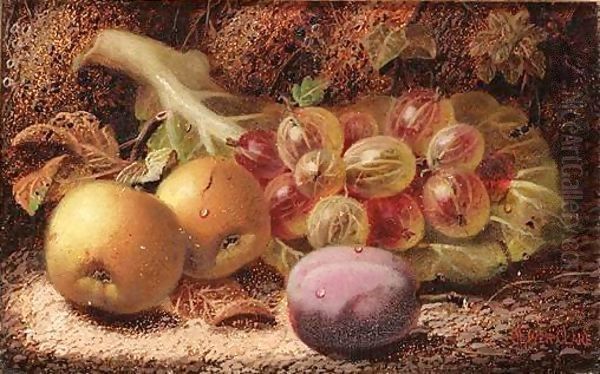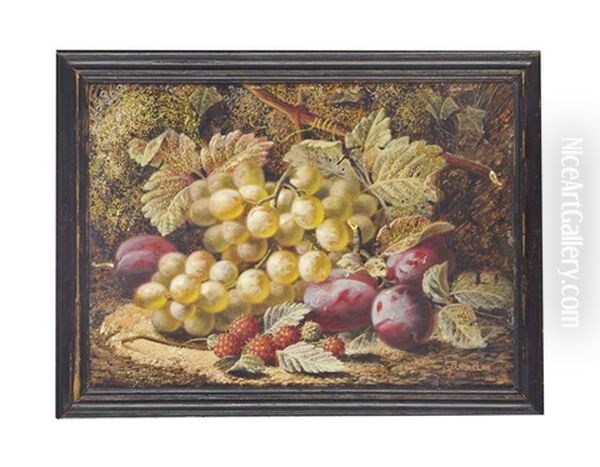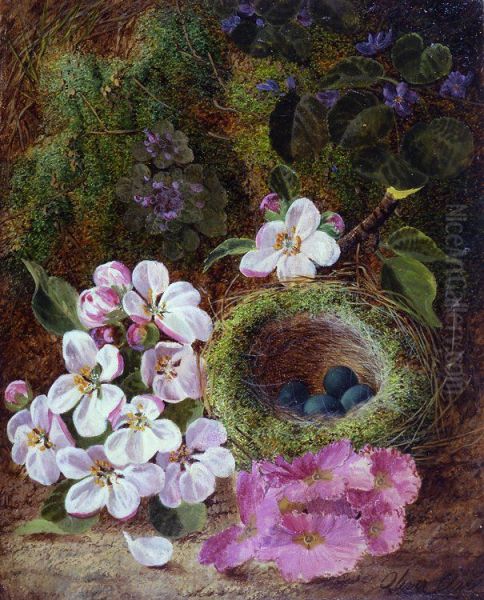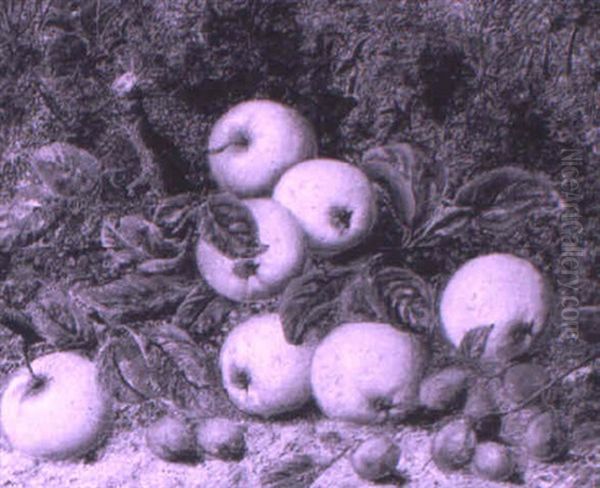Oliver Clare (1853-1927) stands as a significant figure in the tradition of British still-life painting during the late Victorian and Edwardian eras. A painter renowned for his meticulous attention to detail and highly finished canvases, Clare specialized in depicting the quiet beauty of nature, particularly arrangements of fruit and flowers often set against naturalistic backdrops like mossy banks. His work continues to be appreciated for its technical skill and charming portrayal of the natural world.
Origins and Artistic Lineage
Born in Birmingham, England, in 1853, Oliver Clare entered a world already steeped in art. His father was George Clare (circa 1835–circa 1900), himself a well-regarded painter celebrated for his own exquisite still-life compositions. This familial connection proved profoundly influential. While concrete records detailing Oliver Clare's formal artistic education are scarce, it is widely accepted within art historical circles that he received the bulk, if not all, of his training directly from his father.
The artistic dialogue between father and son is evident in their work. George Clare was known for his finely detailed depictions of flowers, fruit, and birds' nests, often employing a delicate stippling technique – the application of paint in small dots or short strokes – to achieve remarkable textural effects. This technique, possibly influenced by the work of earlier watercolourists like William Henry Hunt (1790-1864), allowed George to capture the velvety bloom on fruit or the intricate structure of a bird's nest with uncanny realism.
Oliver Clare clearly absorbed these lessons. His own paintings demonstrate a similar dedication to precision and a comparable mastery of the stippling method. The subjects he chose – ripe fruits glistening with dew, wildflowers nestled in verdant moss, carefully arranged blossoms – echo his father's oeuvre. This strong paternal influence shaped Oliver's artistic path, providing him with a solid technical foundation and a thematic focus that he would pursue throughout his career. He spent the majority of his working life based in Birmingham, the city of his birth, contributing to its vibrant artistic community.
Artistic Style and Technique

The hallmark of Oliver Clare's style is its meticulous realism and high degree of finish. He worked primarily in oils, applying paint with precision to create surfaces that are smooth yet rich in detail. His approach was far removed from the broader, more expressive brushwork gaining traction with Impressionism and Post-Impressionism during his lifetime. Instead, Clare belonged to a tradition that valued careful observation and painstaking execution.
His use of the stippling technique, inherited from his father, was central to achieving the desired effects. By applying small touches of colour, he could build up form and texture gradually, mimicking the complex surfaces found in nature. This is particularly evident in his rendering of mossy banks, a frequent setting for his compositions. The intricate, almost pointillist application of greens, browns, and yellows creates a convincing illusion of damp, springy moss.
Clare also possessed a keen eye for the effects of light. His fruit subjects often seem to glow, their surfaces reflecting light in a way that emphasizes their ripeness and volume. Dewdrops or subtle highlights are rendered with pinpoint accuracy, adding to the sense of freshness and immediacy. He typically favoured clear, naturalistic lighting rather than dramatic chiaroscuro, allowing the inherent colours and textures of his subjects to take centre stage. His compositions are generally straightforward, focusing attention directly on the still-life arrangement without distracting backgrounds, although the naturalistic settings he favoured provide context and charm.
Favourite Subjects and Themes
Oliver Clare's artistic world revolved around the intimate details of nature. His most characteristic works feature arrangements of fruit, often depicted with photographic clarity. Plums, peaches, grapes (both green and black), strawberries, and cherries were frequent subjects, often shown spilling from baskets or arranged artfully on the ground. He captured the delicate bloom on a plum's skin, the translucency of grapes, and the precise texture of a strawberry with equal skill.
Flowers also feature prominently in his work, particularly wildflowers and spring blossoms rather than exotic hothouse varieties. Primroses, violets, and apple blossoms might be shown clustered together, often combined with elements like birds' nests containing delicately speckled eggs. These compositions evoke a sense of the English countryside and the changing seasons.

A recurring and distinctive motif in Clare's work is the mossy bank. Rather than placing his still lifes on polished tables or against dark, ambiguous backgrounds common in earlier traditions (like those of the Dutch Golden Age painters such as Willem Kalf or Jan Davidsz. de Heem), Clare often situated his fruit and flowers directly within a natural setting. This approach lends his paintings an appealing freshness and a connection to the outdoors, suggesting items gathered on a country walk. This focus on naturalistic settings aligns with a broader Victorian interest in nature, botany, and the detailed observation of the environment, seen also in the works of the Pre-Raphaelites like John Everett Millais or William Holman Hunt, albeit with different symbolic or narrative aims.
Representative Works
Oliver Clare was a prolific painter, and numerous examples of his work survive, frequently appearing in galleries and at auction. Among his representative titles, which showcase his typical subjects and style, are:
Still Life of Fruit (often painted as pairs)
Spring Flowers and Grapes
Still Life of Flowers and Bird's Nest
Still Life of Fruit (a common, descriptive title for many works)
Strawberries and Cherries
Plums, Peaches and Blackberries
Grapes, Strawberries and Cherries
Still Life of Fruit on a Moss Covered Stone
These titles clearly indicate his preferred subject matter. Works like Flowers on a Mossy Bank or Still Life of Fruit on a Moss Covered Stone explicitly highlight his characteristic use of naturalistic settings. The frequent depiction of specific fruit combinations, such as Plums, Peaches and Blackberries, demonstrates his careful observation of seasonal produce. Many of his works were relatively small in scale, suited for domestic interiors, further enhancing their intimate appeal.
Exhibitions and Recognition
Throughout his career, Oliver Clare achieved a degree of recognition within the established art institutions of his time. He exhibited his works at several prestigious venues, indicating acceptance by the art establishment and providing exposure to potential patrons. Records show his paintings were displayed at the Royal Academy of Arts in London, a primary goal for many British artists seeking validation and sales.
He also exhibited frequently at the Royal Birmingham Society of Artists (RBSA), reflecting his strong ties to his home city's art scene. Birmingham had a thriving artistic community during the Victorian era, supported by industrial wealth and civic pride. Other notable artists associated with Birmingham during or around Clare's time included figures linked to the Birmingham School of Art and the Arts and Crafts movement, such as Arthur Joseph Gaskin, and later figures with Birmingham roots like Walter Langley of the Newlyn School or the late Pre-Raphaelite Edward Robert Hughes. Clare's participation in RBSA exhibitions placed him firmly within this local context.

Furthermore, his work was shown at the Royal Glasgow Institute of the Fine Arts, demonstrating reach beyond his immediate region. His paintings also appeared at the Walker Art Gallery in Liverpool and the Manchester City Art Gallery, major provincial institutions. This pattern of exhibition suggests a consistent, professional career, engaging with the primary platforms available to artists of his era. Beyond the gallery system, Clare's work also found a broader audience through commercial reproduction; some of his still lifes were painted for local businesses, possibly including health companies, and subsequently reproduced as popular postcards and posters, indicating their wide appeal.
The Victorian Context: Realism, Detail, and the Market
Oliver Clare worked during a period when detailed realism held considerable sway in British art, particularly among middle-class patrons. The Victorian era saw a fascination with scientific observation and the cataloguing of the natural world, which found reflection in the arts. The intricate detail seen in Clare's work resonated with this sensibility, offering viewers a seemingly faithful representation of nature's bounty. This taste for meticulousness can also be seen, though with different motivations, in the work of the Pre-Raphaelite Brotherhood earlier in the century.
While avant-garde movements like Impressionism were developing in France and slowly influencing British artists (such as Philip Wilson Steer or Walter Sickert later in Clare's life), traditional forms like still life, landscape, and narrative painting remained highly popular in Britain. Artists like Clare, who excelled in established genres and demonstrated high levels of technical skill, found a ready market. His detailed, often jewel-like paintings were well-suited to Victorian interiors.
Other British artists specializing in still life during this period included figures like Edward Ladell, known for his compositions featuring wine glasses and fruit, Eloise Harriet Stannard of the Norwich School, and Albert Durer Lucas, who often included insects in his detailed floral pieces. Earlier influential figures in British still life included George Lance. While Clare's work shares a commitment to realism with these contemporaries, his particular focus on naturalistic settings like mossy banks helps to distinguish his style. He stands apart from the grand Academic painting of figures like Lord Leighton or Lawrence Alma-Tadema, focusing instead on more intimate and accessible subject matter.
Contemporaries and Comparisons
Situating Oliver Clare within the broader landscape of late 19th and early 20th-century British art involves acknowledging a diverse range of practices. While he focused on still life, landscape painting flourished with artists like Myles Birket Foster (known for detailed watercolours of rural scenes) or Benjamin Williams Leader (popular for his expansive landscapes). Genre painting, depicting scenes of everyday life, also remained popular.

In the realm of still life, comparisons can be drawn with his father, George Clare, and other specialists like William Hough and John Sherrin, who also produced detailed studies of fruit and flowers. However, Oliver Clare's consistent use of the mossy bank setting provides a signature element. His meticulous technique contrasts sharply with the emerging looser styles influenced by French Impressionism, as seen in the work of British Impressionists.
It is important to note that while the provided source material confusingly mentioned 17th-century miniaturists like John Hoskins and Samuel Cooper, or Peter Oliver, these artists belong to a much earlier period and have no direct connection to Oliver Clare (1853-1927) or his circle. The relevant contemporaries are those active in the British art world from roughly the 1870s through the 1920s. This includes not only still-life painters but also landscape artists, portraitists, and proponents of various movements from late Pre-Raphaelitism to early modernism, providing a rich backdrop against which Clare pursued his specific artistic path.
Art Historical Assessment and Legacy
Art historical evaluations of Oliver Clare often acknowledge his exceptional technical skill while also addressing the profound influence of his father. Some discussion revolves around the degree of originality in his work, given its close stylistic and thematic ties to George Clare's paintings. He is generally seen not as a major innovator who broke new ground, but as a highly accomplished practitioner within an established tradition. His dedication to detailed realism placed him somewhat outside the main currents of artistic innovation that were gathering pace during his later career.
However, this assessment does not diminish the quality or appeal of his work. His paintings are admired for their decorative qualities, their technical finesse, and their charming depiction of nature. They represent a specific taste prevalent in the Victorian and Edwardian periods for finely wrought, naturalistic art. His works continue to be sought after by collectors who appreciate traditional craftsmanship and the enduring appeal of still-life painting.
The "controversy" surrounding his evaluation is less about outright dispute and more about placing his contribution accurately within the history of British art. He mastered a specific style and subject matter, heavily influenced by his father, and produced a large body of consistent, high-quality work that found favour with the public and exhibition committees of his day. His legacy is that of a dedicated specialist, a master of the detailed still life whose paintings offer a window onto the aesthetic preferences of his time and continue to delight viewers with their intricate beauty.
Conclusion

Oliver Clare died in London in 1927, leaving behind a substantial body of work dedicated almost entirely to the genre of still life. As the son of George Clare, he inherited a strong artistic tradition and technical approach, which he refined throughout his career. Working primarily in Birmingham, he gained recognition through exhibitions at major institutions like the Royal Academy and the RBSA. His paintings, characterized by meticulous detail, the use of stippling, and often featuring fruit and flowers set against naturalistic mossy banks, exemplify a particular strand of late Victorian and Edwardian realism. While perhaps not an innovator in the mould of his more avant-garde contemporaries, Oliver Clare remains a respected and collected artist, admired for his unwavering commitment to capturing the delicate beauty of the natural world with remarkable precision and charm.